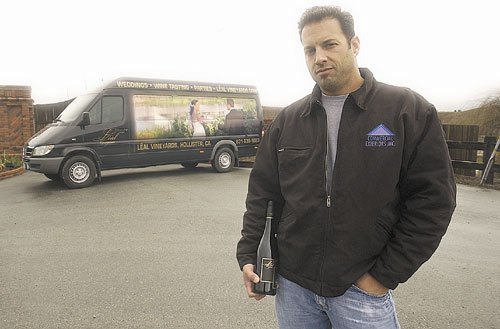A year ago, Frank Leal bought a 2006 Dodge Sprinter van with a
diesel engine.
A year ago, Frank Leal bought a 2006 Dodge Sprinter van with a diesel engine.
It’s painted black with a gold, cursive Leal logo – like the labels on his wine bottles. An image of a happy couple, at their wedding on the vineyard, runs along its back door and windows.
The van serves two purposes for Leal – owner and founder of the winery east of Fairview Road in San Benito County – advertising and, in a time of $100 barrels of oil, a way to beat fuel surcharges.
Leal Vineyards delivers about 40 percent of its wine – or 4,000 cases – with the van. It helps offset the cost of surcharges on deliveries of packaging material, Leal said.
“We’re getting hit with everything,” Leal said. “Labels, corks, bottles, anything we order, we get hit with a surcharge.”
Delivery of those goods adds 10 to 15 percent onto Leal’s costs, he said.
“And who has to pay for that?” Leal said. “We have to pass it on to the consumer. It’s part of inflation.”
With the van, Leal at least avoids paying a surcharge for delivering the finished product to local stores here and in adjacent areas, such as Santa Clara, Santa Cruz and Monterey counties, he said. The van gets 28 miles to the gallon.
Wineries in Gilroy are all dealing with the same choices, too.
“Business is business,” said Alex Larson, co-owner of the Rapazzini Winery in Gilroy off U.S. 101. “Fuel costs don’t affect us that much, but they do affect the customer because we’re paying fuel charges for them from UPS and through the big freight shippers, as well.”
“In the end – no matter what – the consumer is going to be paying for the added costs,” Larson said, “whether it goes up because land, taxes or whatever.”
As the manager of the Garlic Shoppe in the Gilroy Premium Outlets, Charlie Larson has also had to pass on increased fuel costs to garlic lovers across the country, most of whom buy the store’s pickled garlic, he said. Sales are still good, but Larson said UPS just raised his rates again earlier this month for the second time in 12 months.
“We have no choice but to pass costs on to consumers,” Larson said. “They’re still paying the extra cost, but I think they’re thinking about it now … You know, paying $20 for something and then another $7 for shipping.”
Other companies are also dealing with huge fuel surcharges for delivery of products.
Guerra Nut Shelling Co. on Hillcrest Road in Hollister packages both in-shell and shelled walnuts for large retailers in the U.S. The company ships internationally – mainly to Italy but also to countries such as Germany, France, Spain, Israel and Australia depending on the year. Most of the walnuts are shipped out in cargo containers on trains, said Frank Guerra, co-owner of the nut shelling company.
Guerra uses a contract hauler to ship in tons of walnuts by truck from the Central Valley every fall for processing and packaging. During its peak season, the company receives up to 250 tons of walnuts per day.
“In the last seven years it’s gradually gone up,” Guerra said of fuel surcharges, “And the last several years especially.”
In 2001, the fuel surcharge was 4 percent, Guerra said.
Last year, the fuel surcharge hit 25 percent, doubling since 2004, Guerra said.
“It’s topped out this year,” Guerra said. “I hope.”
The company has two options – pass the cost to the growers or consumers. Guerra said the cost is ultimately passed to the consumers.
Delivery companies have various methods to determine a fuel surcharge.
UPS uses a fuel surcharge based on the U.S. Department of Energy’s reported National U.S. Average On Highway Diesel Fuel Price from two months prior, according to the company’s Web site.
This month’s charge – which is 6.75 percent – is based on the November 2007 price average of at least $3.50 but not more than $3.58 per gallon of diesel fuel.
Staff writer Chris Bone contributed to this report.














